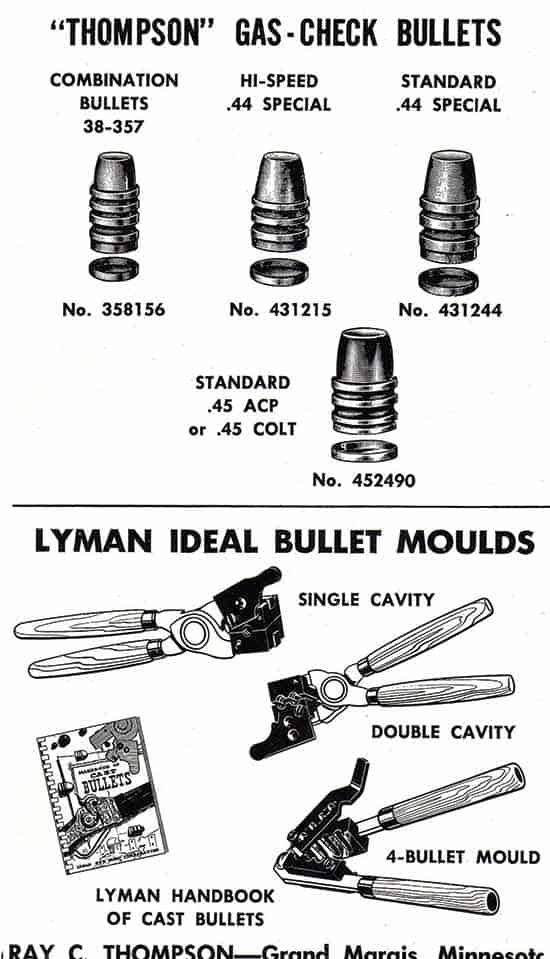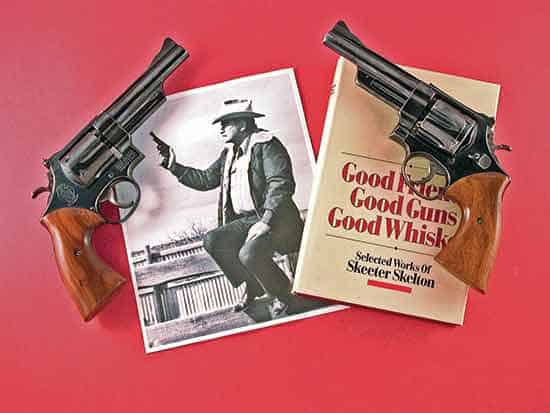Past Masters of the DA Sixgun
Skeeter & Ray Thompson
There’s no doubt we’re living in the age of the semi-auto. This wasn’t always the case and during the last century, especially from the 1920s to the 1970s, the DA sixgun was definitely king.
There were many men who raised the use of the double action to a high art and science. These men need to be remembered for their contributions. With this in mind let’s go back in history when six shots were the norm — and all that was usually needed. All of these men are now gone, and as a kid never did I ever imagine I would actually know many of these sixgunners.
Skeeter Skelton
In the late 1950s, I “discovered” Skeeter Skelton. At the time he was a county sheriff and freelancing for gun magazines. He always seemed to write articles about real sixguns — traditional sixguns. Guns I could easily identify with. Skeeter had been a border patrolman before his sheriffing and had plenty of experience with sixguns. His favorites were the 5″ S&W Model 27 .357 Magnum, the 4″ S&W .357 Combat Magnum Model 19 — which was designed by his good friend Bill Jordan — and the 4″ S&W Model 1950 Target .44 Special.
I first met Skeeter at the Outstanding American Handgunner Awards Foundation Banquet in 1978, the year he was named Outstanding American Handgunner. Walking up to him, I handed him a picture without saying a word. He grabbed me by the arm and said, “Let’s go someplace where we can talk.” The picture I showed him was the instant access to his heart. It was the close-up of the barrel of a gun my wife had just bought for me, a Colt Single Action Army with the barrel marked “Russian and Smith & Wesson Special 44.” I knew when Skeeter saw that picture, I would have an “in.”
That old Colt .44 was a very rare sixgun, made in the 1920s. I found it advertised in the local paper for $450, went and looked at it, but decided it was more than I could afford. The next day my wife picked up my repaired boots at the boot shop and when she handed them to me they seemed awfully heavy. They were. In one boot was the 7-1/2″-barreled .44 and in the other was the belt and holster coming with it. An understanding wife is the joy of a man’s soul and spirit.
Skeeter and I talked about that gun for quite a while. It had been carried by a Colorado sheriff, and the light pitting on the top strap was from his blood when he was shot. He was naturally more concerned about getting himself patched up than cleaning the gun. He healed, the gun did not, hence the lasting memento of a shootout still adorned the grand old Colt.
Sedate Loads
I knew I would get right to Skeeter’s heart when he saw the picture. He loved Colt Single Actions in general and .44 Specials in particular. Like Elmer Keith, Skeeter also used the standard Keith Heavy .44 Special load in his .44 Specials until the .44 Magnum came along. Then he dropped to a more sedate loading of 7.5 grains of Unique for the .44 Special for 900-1,000 fps depending upon the gun and barrel length. It’s a load all sixgunners will recognize as the Skelton load. Skeeter called this the ultimate defensive loading for sixguns and used it extensively in a 4″ 1950 Target .44 Special. The bullet? Need you ask? The Keith/Lyman 429421 was the most used .44 bullet in Skelton’s .44 Special and .44 Magnum loads.
A great and lasting contribution to DA sixgunners from Skeeter is the Skeeter Skelton style of grips for the K- and N-Frame S&Ws. Skeeter started with the best design available at the time, the Walter Roper grip, modifying it by making it smaller and rounder. The result is, to my way of thinking, the best grip design available for a DA revolver. These grips today are available from BluMagnum.
When Skeeter went on staff of Shooting Times, I was fresh out of college and had moved my wife and three pre-school age kids 2,000 miles across country, settling in Idaho. During my college years I had worked full-time in a factory, then entered teaching taking a pay cut, followed by the move and another pay cut. To put it mildly we were broke and there was no money for firearms — however shooting magazines were always part of the grocery list.
Magic
Skeeter had a wonderful knack for drawing readers into his articles and fueling dreams at the same time. For several years I existed on those dreams. In August 1966 Skeeter did an article on the .44 Special and pictured a 5-1/2″ Colt New Frontier .44 Special with an extra cylinder in .44-40. I dreamed over that picture many times wondering if I would ever have such a beautiful sixgun myself. Skeeter kept me going until I actually could have such a .44 Special.
The same year S&W dropped the 1950 Model Target .44 Special and Colt followed, removing the .44 Special in the SAA. The Colt New Frontier followed, and in one short brief span of time all full-size .44 Special sixguns disappeared, leaving only the 5-shot Charter Arms Bulldog. This is a fine little revolver, however it’s more for concealed carry. For target shooting and hunting, the .44 Special was dead. Buried. Forgotten except by the dedicated few.
Something had to be done. Someone had to speak out. The only man who really appreciated the .44 Special and was in the position to speak out was Skeeter, and speak out he did. In the April 1972 issue of Shooting Times Skeeter said, “The .44 S&W Special is the finest all-around handgun cartridge ever loaded, and in my experience, it is a bit more accurate than the ballyhooed .38 Special.” He talked of the many letters he received from sixgunners looking for .44 Specials and also shared correspondence with both Colt and S&W saying they were basically too busy filling orders for their more popular models to offer the .44 Special.
The Return
Skeeter not only wrote about the return of the .44 Special, he also instigated a letter writing campaign and was able to announce “Victory At Last” in a Shooting Times article, with the return of the .44 Special to the Colt Single Action Army lineup, followed by the return of the .44 Special New Frontier. Four years later S&W came out with the Model 24-3 .44 Special in both 4″ and 6-1/2″ lengths followed with the Model 624 in stainless steel version. Special runs were also offered in both blue and steel with 3″ barrels. Sadly all of these are now gone. Since then, S&W has offered two 5-shot L-Frame .44 Specials, the Model 296 and 696, a Thunder Ranch Special, and a Classic Model 24, however these are also now gone.
January 2018 marked the 30th Anniversary of Skeeter’s passing. He inspired me, a young sixgunner, in the late 1950s and when I encounter a writer’s block I still find myself looking to his writings for inspiration.
Ray Thompson
Forest Ranger Ray Thompson was a true genius of bullet design. All of his bullets are semi-wadcutter styles with gas checks. His .357/.38 Special bullet 358156, is still one of the best bullets available for standard loads in the .38 Special and .357 Magnum. The original 1930s loads for the .357 Magnum leaded the barrel very quickly. Those factory bullets (before the age of jacketed bullets) were too soft for the muzzle velocities possible in the first magnum cartridge.
Handloaders would struggle with this problem until Ray Thompson’s “Magic Bullets” appeared. For my use the Thompson Bullet 358156 GC, weighing around 158 grains with gas check installed, is still the best standard weight bullet for the .357 Magnum. I’ve used Thompson bullets for over 50 years in the .38 Special, .357 Magnum, .44 Special, .44 Magnum, .45 Colt and .45 Auto Rim. The latter bullet was specially designed for use in the S&W 1950 Target .45, and Thompson reported it being used for coyotes out to 100 yards.
“I designed these bullets with gas checks primarily for the elimination of leading in Magnum loads, with excellent accuracy both at long-range and on target,” said Thompson. “Bullet 358156 is designed with two crimping grooves, the first groove for use in crimping the .357 Magnum and the second for crimping the .38 Special case, allowing more powder space using 2400 powder for magnum loads in Heavy Duty guns.”
Skeeter’s favorite .357 Magnum load was actually assembled with .38 Special cases, 13.5 grains of 2400, and the Thompson bullet crimped in the lower crimping groove. When I started loading for the .357 Magnum it was easy to find .38 Special brass, however .357 Magnum brass was not so easy to acquire. I started using the Keith bullet in .38 Special brass and then once I got a Thompson bullet mold I switched to the Skeeter Load. I find it is still an excellent load.
All of Thompson’s bullet designs are still available from Lyman. I’ve found the .44 Magnum bullet, number 431244, to be exceptionally accurate and will often perform great in .44 Magnums which don’t shoot well when used with plain-based cast bullets. The same can be said for bullet number 452490 when used in either .45 Colt or .45 Auto Rim sixguns. The .44 bullet weighs 255 grains and the .45 Colt/.45 Auto Rim is at 250 grains, both with my alloy.







